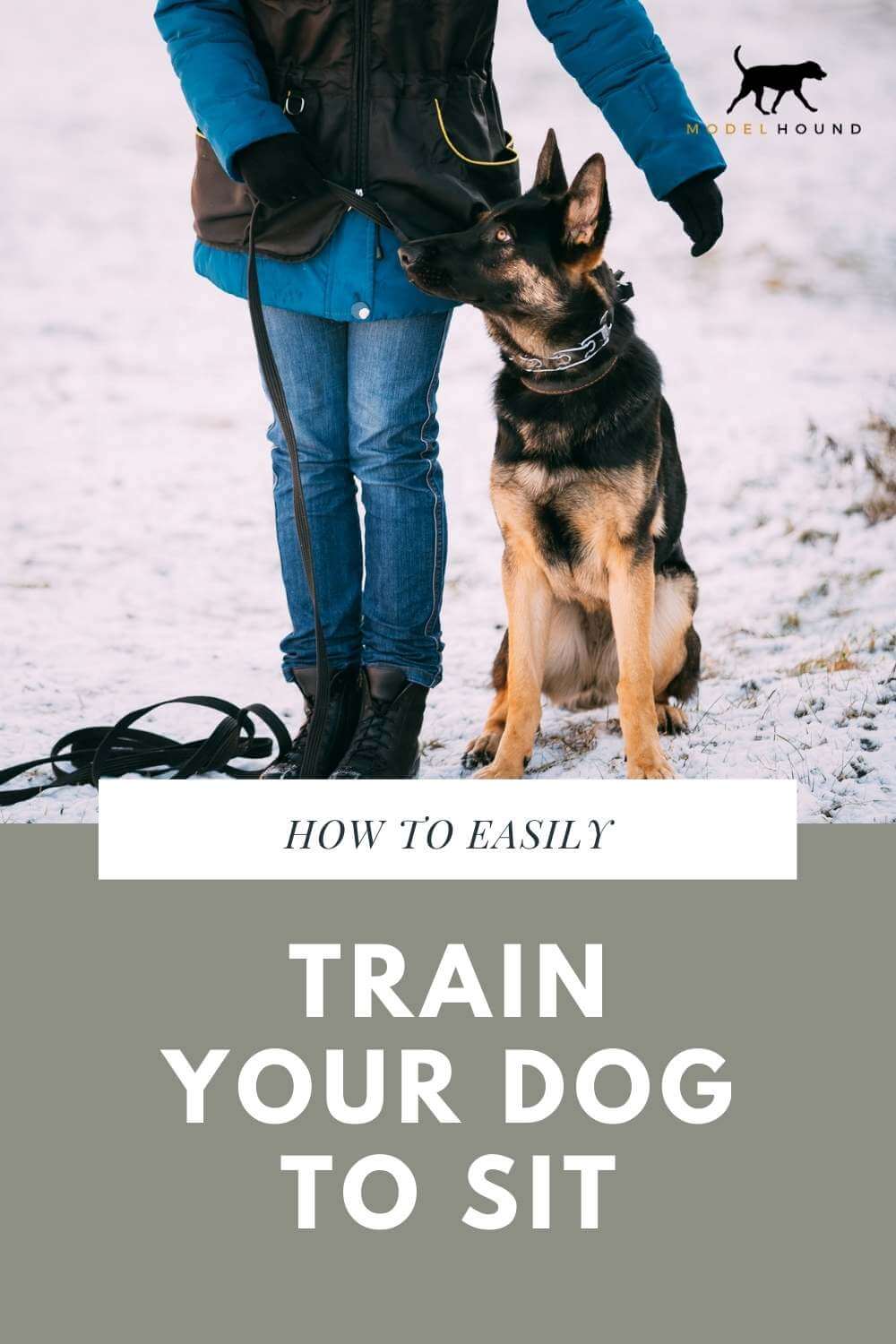Training Your Dog to Sit
Training your dog to sit is one of the first lessons that you and your new puppy or older dog must master. It's a crucial step in dog training, and one that you really can't skip! In obedience training, it's called the "sit-at-heel" or "heel position" - where your dog is sitting nice and straight at your side (usually the left side for training purposes).
That's probably a bit of a different picture than what you may be used to... many dog owners settle for having their dog sit where-ever he feels like, whether that be beside you, in front of you, behind you, or 10 feet away from you!
I can see you scratching your head already. So why is this a problem? Well, obedience training is about precision and control. Dogs need to learn to control their instincts to chase squirrels, to jump, to bark.
Therefore, when
we teach a dog a new command, we have to very black and white about
what that command means. This makes it easy for your dog to learn
what you expect from him.
And always keep a leash on your puppy or new dog while he is learning a new command! This way, you are able to follow through on a command in case he doesn't want to listen! A good rule of thumb is that if you aren't 150% sure that your dog will listen to you, don't take the leash off.
Training your dog to sit must be black and white - no grey areas - or your dog will get confused!
Getting Started
Before you start training, let's get all your dog training tools together and ready to go. When training your dog to sit, you'll need the following:
- leather or nylon training leash, preferably 6 feet long
- dog training collar
appropriate for your dog's age and temperament.
There is a lot of mixed opinions on training collars. The fact is, your dog needs one. Trying to train a dog without a training collar is a lot like trying to drive a car without power steering. - a few soft, aromatic treats
It's best to start training your dog to sit somewhere quiet, with few distractions around. Once your dog learns the command, you can start adding distractions to practice the new exercise.
Before starting any training session, it's a good idea to put your dog's collar on about half an hour beforehand. This is to prevent your dog from becoming "collar-trained", where he behaves one way when the collar is on, and misbehaves when the collar comes off. Also, leave it on for about a half hour after your training session, too!
 Proper collar position on your dog's neck for training your dog to sit.
Proper collar position on your dog's neck for training your dog to sit.Once the collar is on and fitted properly, clip your leash on and use
two hands to gently pull the collar up nice and high behind your dog's
ears and under his chin.
This will give you the best control with the least amount of muscle needed, as your dog doesn't have a lot of muscle up there.
Keep in mind, a properly fitted collar will slide down your dog's neck while training - this is normal. You'll have to gently pull it back up every few minutes while training to keep it up high!
Training Your Dog to Sit:
The Command
Let's get right into it. You'll want to have a couple soft treats in your pocket.
Start by holding the leash gathered up in your right hand at your naval, left hand grasping the leash where it's hanging loosely.
The collar shouldn't be pulled tightly, so move your left hand up the leash a little to make sure that it is loose.
The photo below shows you how to hold the leash, and where your dog should be sitting once you've told him to sit (follow the steps below).
Milo's collar is up nice and high on his neck, and there is a small "J" in the leash where it clips on to the collar - the leash should hang nice and loose!
 Heel position when training your dog to sit.
Heel position when training your dog to sit.So what's the command when training your dog to sit? With your dog standing on your left side...
- Command "sit" in a firm but normal tone of voice (only say it once!).
- Wait three seconds to give him a chance to comply.
- If he sits, give him some praise, but don't go overboard or he may get excited and stand up again.
- If he doesn't sit, move your right hand and grasp the metal clip of the leash (without dropping the end that you are already holding), and let go of the leash with your left hand. Move your left hand to your dog's rump.
Simultaneously, use 75% pressure to pop up on the collar for 1 second and 25% pressure to gently push his rump down. A dog's neck is much stronger than his hips, so be sure to pop up firmer than you are pushing down! - Immediately loosen the leash again and praise as soon as your dog is sitting. Stand up straight and hold the leash as you were at the beginning again.
How to Correct When Training Your Dog to Sit
Let's assume for a moment that you have given the "sit" command, and your dog is now sitting at your left side.
Sit means sit - so while on command, he's not allowed to sniff the floor, lie down, stand up, or even shake-a-paw. He's allowed to look around by moving his head (not his rear end!) and breath.
Sound hard-core? It is! This is how you get a well-trained, reliable dog! It's not being mean... in fact, it makes it easy for your dog as he knows exactly what he should/should not do.
In the case of Rover sniffing the floor for a stray treat, or starting to stand up or lie down, don't say anything! You want your dog to learn to hold the first command that you gave him until told otherwise.
Simply move your right hand with the whole leash gathered in it to the metal clasp, loosen, pop straight up, and loosen again in a fast, fluid motion. Remember - it's only a one-second correction!
Simultaneously, use your left hand to gently press down on his rump and steer him into a straight sit beside you again.
Then praise him! Stand upright and be ready to correct again if he moves out of a sit.
 How to correct when training your dog to sit.
How to correct when training your dog to sit.The "Release" Command
Hopefully by now training your dog to sit is moving along well. You understand that sit means sit, and Rover isn't allowed to sniff, stand up, lie down, or shake-a-paw while "on command".
But you're probably wondering, how do I release him from the command?
Training your dog to sit is really a two-step exercise. You need to be able to tell him to disengage from the exercise as well! This is called the release command. And yes, it's still a command... whether he wants to or not, your dog does have to get up from the sit when you tell him to.
So how do you go about this? Obviously, you need to have your dog sitting nicely at your left side to begin. Wait until he is not trying to pop up right away, but is sitting quietly.
Choose a word to use as a command. It really doesn't matter which word you choose ("Okay", "Release", "Free"), but keep it short, and be sure to always use the same word for this command to avoid confusing your dog.
Training your dog to sit is a great way to prevent jumping! It teaches proper manners for greeting others.
Got your word picked? With your dog sitting nicely at your side, say your release command in a happy, higher-pitched, almost sing-songy tone of voice.
Why the different tone? Well, you want your dog to be able to differentiate between when it's a command, and when you're simply talking to someone and want him to hold a stay command.
You don't want to have to worry about accidentally saying that word in everyday conversation, so if you use a higher-pitched, happy tone, he will only listen to that tone for this command!
Now, your dog may just sit there and look at you. That's normal... he doesn't know what that word means yet.
Wait three seconds to give him a chance to comply, and if he stands up on his own, praise him. If he stays sitting, open your left hand and give him a gentle push on the withers (area where his shoulders are) or under his belly (but not a belly rub!). Praise him when he gets up.
On a release command, your dog is free to do what he wants, like a break time. You, however, must keep your feet planted where you are, and hold the end of leash.
Your pooch can go the length of the leash, so 6 feet around you if that's how long your leash is. If you want to end the training session, give your release command and then unclip the leash.
Practice Makes Perfect
Just like anything, the more you practice training your dog to sit, the more consistent and reliable he's going to become!
Follow these steps, and you'll have no problems training your dog to sit! See? I told you it wouldn't be hard.
- Home
- Basic Training
- Training to Sit


